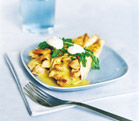
Types of Latin Dancing
Salsa dancing, a type of Latin American dancing with the musical accompaniment of African, Cuban and Latin-American rhythms, is a partner dance with all the flavor and style of the Spanish "sauce". Dancing to salsa music entails a partner in order to dance to an eight beat pattern in a fixed area (in this "spot" dance, the couple does not travel a great deal around the floor as in ballroom dancing).
La Rumba is a generic term for an assortment of names (e.g. Son, Danzon) for West Indian music and dance. The native Rumba folk dance of African influence is a sort of sex pantomime in which the partners dance rumba very fast and with hyperbolically sexy hip movements (the man sexually aggressive while the woman behaves defensively). The "Son" dance of rumba (a slower paced and more polished version of native La Rumba) was the popular dance of the Cuban middle class as early as WWII. Dancing rumba even slower, the "Danzon" was performed by aristocratic Cuban society and entails tiny steps and slight tilting by the female.
Festive in style and temper, samba dancing and samba rhythm are festival dances generally performed during Brazil street festivals and celebrations. A branching off of the Mambo dance, the cha cha cha dance became popular around 1954 and consists of three rapid steps (cha cha cha slide) and two slower steps on the one and two beat.
A traditional folk dance meaning "two-step" in Spanish, the Paso Doble dance is a bullfight representation in which the male traditionally acts as the Matador and the partner acts as the cape. Its marching character and dramatic stances give the Paso Doble dance a very recognizable quality.






